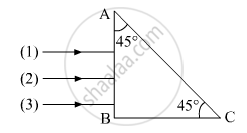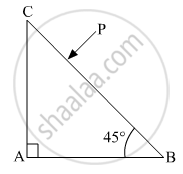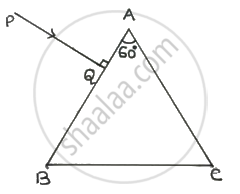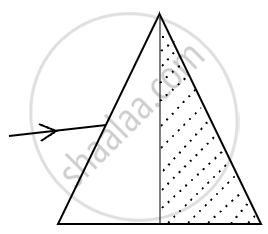Advertisements
Advertisements
प्रश्न
A ray of light is refracted by a glass prism. Obtain an expression for the refractive index of the glass in terms of the angle of prism A and the angle of minimum deviation δm.
उत्तर
In the given diagram,

OP is the incident ray, which makes the angle i1 normal, and ∠N'QR is the angle of emergence, which is represented by i2. A is the prism angle, and µ is the refractive index of the prism.
A = Prism angle, δ = Angle of deviation, i1 = Angle of incidence, i2 = Angle of emergence.
In the case of minimum deviation,
`∠r_1 = ∠r_2 = ∠r`
A = `∠r_1 + ∠r_2`
So, A = ∠r + ∠r = ∠2r
∠r = `A/2`
Now, again
A + δ = i1 + i2 ....(∵ In the case of minimum deviation i1 = i2 = i and δ = δm)
So, A + δm = i + i = 2i
Now, `i = ((A + δ_m))/2`
Now, from Snell's rule,
`mu = (sini)/(sinr)`
`mu = (sin((A + delta_m)/2))/(sin A/2)`
APPEARS IN
संबंधित प्रश्न
Three rays (1, 2, 3) of different colours fall normally on one of the sides of an isosceles right angled prism as shown. The refractive index of prism for these rays is 1.39, 1.47 and 1.52 respectively. Find which of these rays get internally reflected and which get only refracted from AC. Trace the paths of rays. Justify your answer with the help of necessary calculations.

A ray of light, incident on an equilateral prism `(μ_g = sqrt3)`moves parallel to the base line of the prism inside it. Find the angle of incidence for this ray.
Trace the path of the ray (P) of light passing through the glass prism as shown in the figure. The prism is made of glass with critical angle ic = 41°.

Suggest a method to produce a rainbow in your house.
A small object is embedded in a glass sphere (μ = 1.5) of radius 5.0 cm at a distance 1.5 cm left to the centre. Locate the image of the object as seen by an observer standing (a) to the left of the sphere and (b) to the right of the sphere.
The refractive index of a prism whose angle A = 60° is `sqrt2`. Then the angle of minimum deviation δm will be ______.
A ray PQ is incident normally on the face AB of a triangular prism of refracting angle 60° as shown in figure. The prism is made of a transparent material of refractive index `2/sqrt(3)`. Trace the path of the ray as it passes through the prism. Calculate the angle of emergence and the angle of deviation.

Two prisms ABC and DBC are arranged as shown in the figure.

The critical angles for the two prisms with respect to air are 41.1° and 45° respectively. Trace the path of the ray through the combination.
The maximum value of the index of refraction of a material of a prism which allows the passage of light through it when the refracting angle of the prism is A is ______.
A ray of light when incident upon a thin prism suffers a minimum deviation of 39°. If the shaded half portion of the prism is removed, then the same ray will ______.

